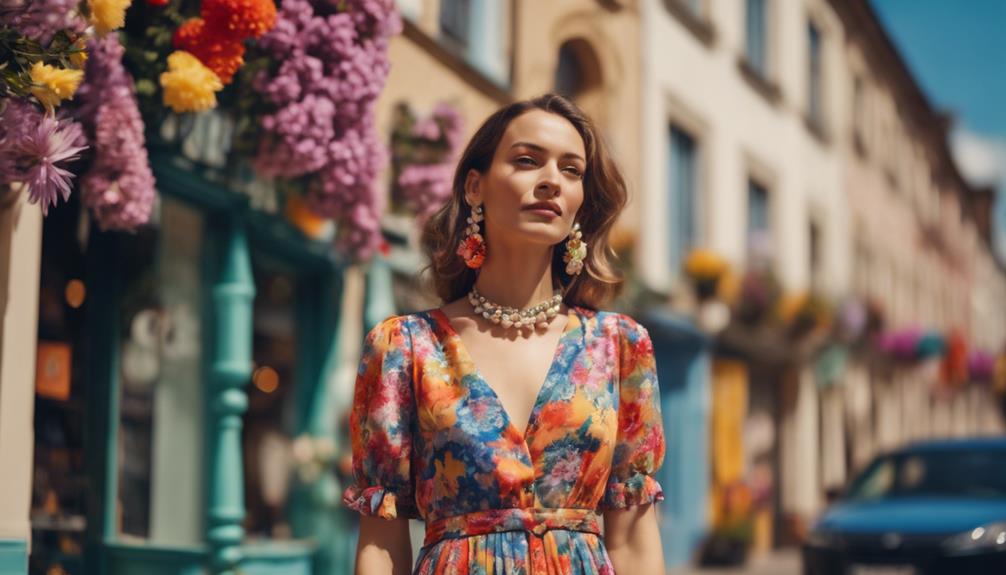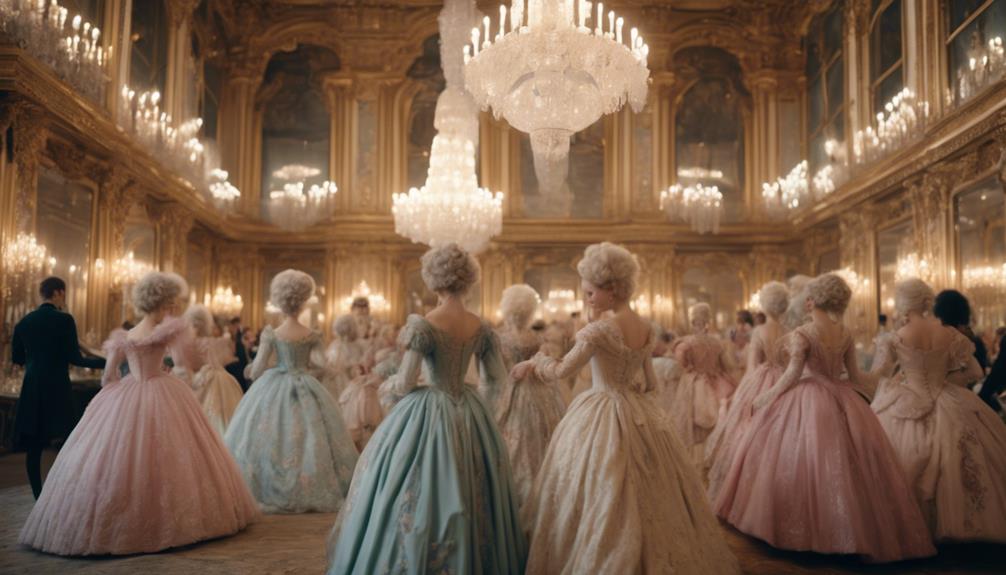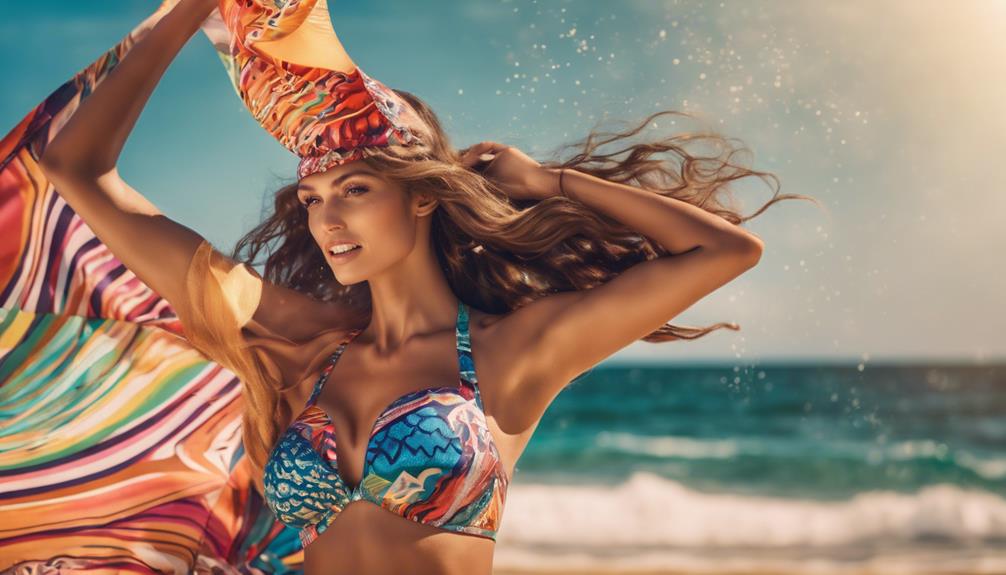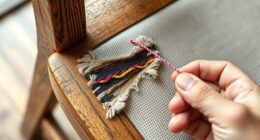Frugal women’s fashion allows you to showcase your personal style without breaking the bank. By prioritizing sustainable fabrics, timeless essentials, and versatile layering pieces, you can put together stylish outfits on a budget. Think of classic denim jackets and high-quality basics as the building blocks of your wardrobe. Adding in upcycled items can give your look a unique twist while supporting sustainability. Consider shopping for secondhand pieces and following smart shopping practices to make the most of your budget. You can seamlessly combine fashion with ethics. For additional tips on curating a fashionable and budget-friendly wardrobe, there is plenty more to discover to take your fashion sense to the next level.
Key Takeaways
- Embrace sustainable fabrics like organic cotton and Tencel for stylish, eco-friendly wardrobe choices that reduce environmental impact.
- Invest in timeless staples like denim jackets that offer versatility and longevity, ensuring you get the most out of your budget.
- Create a seasonal capsule wardrobe with 30-40 essential pieces to maximize outfit combinations without overspending on trendy items.
- Utilize layering techniques with high-quality basics and neutral colors to adapt outfits for various occasions and climates effectively.
Origin and historical background of the fashion trend/style
Frugal fashion has roots in historical shifts, reflecting society's response to economic challenges and changing values.
You'll see how icons and movements from the Great Depression to the counterculture of the 60s and 70s paved the way for today's emphasis on sustainability and individuality.
Historical Fashion Shifts
Fashion has undergone significant transformations throughout history, often reflecting societal changes and cultural movements that shape how we express ourselves. The Industrial Revolution in the late 18th century brought mass production, making clothing more accessible and leading to the rise of fast fashion.
However, the 1920s marked a pivotal shift in women's fashion, with flapper styles promoting a liberated, androgynous silhouette that echoed the fight for women's rights and independence.
As you move into the post-World War II era, you'll notice the emergence of haute couture, exemplified by Christian Dior's 'New Look' in 1947, which emphasized femininity and luxury.
The 1960s, driven by youth culture and counterculture movements, further challenged traditional fashion norms, encouraging casual styles and bold prints, making fashion more democratic and expressive.
Fashion Icons and Movements
The evolution of women's fashion has often been shaped by influential figures and movements that reflect changing values and aesthetics, paving the way for new trends like slow fashion and thrift culture.
The slow fashion movement emerged in the early 2000s as a direct response to the fast fashion industry's harmful environmental and social impacts. Designers like Orsola de Castro co-founded Fashion Revolution in 2013, advocating for transparency in fashion brands following the tragic Rana Plaza disaster.
Vivienne Westwood popularized the mantra 'buy less, choose well,' encouraging you to prioritize quality over quantity. This philosophy aligns with the rise of thrift culture in the 2010s, where social media platforms celebrated pre-loved clothing as a stylish and sustainable alternative.
Fashion movements such as minimalism and capsule wardrobes emphasize intentionality in your choices, allowing you to create a versatile wardrobe while reducing waste.
By investing in timeless pieces and supporting sustainable fashion brands, you're not just making a statement; you're participating in a movement that values ethics and sustainability over fleeting trends.
Adopting these principles can transform your wardrobe and promote a more conscious approach to fashion.
Key Characteristics

When you embrace frugal female fashion, you prioritize sustainable fabric choices that are kind to both your wallet and the planet.
Organic cotton and earthy tones not only elevate your style but also support eco-friendly practices.
A timeless denim jacket can serve as a versatile staple, making it easy to create chic outfits while sticking to your budget.
Sustainable Fabric Choices
Choosing sustainable fabrics not only benefits the planet but also enhances your wardrobe with eco-friendly options.
By opting for sustainable fabrics, like organic cotton, you're supporting farming practices that avoid harmful pesticides and fertilizers, ultimately reducing environmental impact. Tencel is another excellent choice; made from sustainably sourced wood pulp, it's biodegradable and uses less water compared to conventional cotton.
Recycled polyester also stands out as a sustainable fabric option. By choosing garments made from post-consumer plastic bottles, you help divert waste from landfills while lowering carbon emissions associated with virgin polyester production.
Additionally, consider hemp, a durable, fast-growing plant that requires minimal water and no pesticides, making it a highly sustainable choice that enriches soil health.
Lastly, linen, derived from the flax plant, isn't only biodegradable but also energy-efficient to produce. It gets softer with each wash, promoting longevity and reducing the need for frequent replacements.
Organic Cotton and Earthy Tones
Organic cotton offers a sustainable and stylish option for your wardrobe, especially when paired with earthy tones that create a natural, calming aesthetic. This fabric is grown without synthetic pesticides and fertilizers, making it an eco-friendly choice that doesn't compromise on style. You'll find that clothing made from organic cotton is often softer and more breathable than conventional options, adding comfort to your everyday looks.
Incorporating earthy tones, like browns, greens, and terracotta, allows you to build a versatile wardrobe that's easy to mix and match. These timeless colors not only reflect a natural vibe but also align perfectly with the principles of slow fashion. By choosing organic cotton pieces in these shades, you're not just enhancing your style but also supporting fair labor practices, ensuring better wages and working conditions for those in the textile industry.
With organic cotton and earthy tones, you can create a cohesive aesthetic that embodies simplicity and elegance. This combination not only keeps you looking chic but also makes a positive impact on the environment and the lives of others.
Timeless Denim Jackets
A timeless denim jacket is a versatile wardrobe staple that effortlessly complements your organic cotton pieces in earthy tones. These jackets easily pair with various outfits, making them perfect for both casual outings and semi-formal events. High-quality denim jackets, often made from durable cotton or a cotton blend, guarantee longevity while resisting wear and tear.
When selecting a timeless denim jacket, consider classic styles such as traditional blue wash or black denim. These options can be dressed up or down, while lighter washes provide a more relaxed vibe.
Look for essential design elements like button-front closures, chest pockets, and functional side pockets, enhancing both style and practicality.
A well-fitting denim jacket should feature a slightly tailored silhouette, allowing you to layer without feeling bulky. This tailored look contributes to a polished appearance, making it an effortless addition to your wardrobe.
Modern Interpretation

In today's fashion landscape, you can embrace sustainable innovations that redefine your wardrobe while being eco-conscious.
By exploring eco-friendly labels and celebrity endorsements, you'll discover stylish options that align with your values.
This modern interpretation of frugal fashion not only enhances your style but also supports a healthier planet.
Sustainable Fashion Innovations
Sustainable fashion innovations frequently transform the industry by introducing eco-friendly materials and advanced technologies that prioritize environmental responsibility.
You'll find that materials like organic cotton, Tencel, and recycled polyester greatly reduce the environmental impact compared to conventional fabrics. Brands are also embracing circular fashion principles, designing garments for longevity and recyclability. This approach minimizes waste and promotes a more sustainable lifecycle for your clothing.
Advanced technologies, such as 3D knitting and digital printing, allow for on-demand production, which means you can enjoy trendy pieces without the excess inventory that often plagues the fashion industry. Additionally, innovations in dyeing processes, like waterless dye technologies, considerably decrease water usage and pollution associated with traditional dye methods, contributing to a cleaner environment.
Lastly, the rise of blockchain technology in fashion enhances transparency in supply chains. This allows you to verify the ethical sourcing and production practices of the clothing you choose.
Eco-conscious Fashion Labels
Embracing eco-conscious fashion labels means choosing brands that prioritize ethical production and materials, helping you make a positive impact on the environment. These labels often use organic materials and recycled fabrics, minimizing their ecological footprint. Well-known brands like Reformation and Patagonia lead the way, showcasing transparency in their supply chains and environmental initiatives.
By opting for eco-conscious fashion labels, you're not just buying clothes; you're investing in timeless, versatile pieces designed to last for years. This approach promotes the slow fashion movement, encouraging you to step away from the fast fashion cycle and its detrimental effects on the planet.
Additionally, you can complement your eco-conscious wardrobe by exploring secondhand and vintage shopping platforms like ThredUp and Poshmark. Buying pre-loved items aligns perfectly with the values of eco-conscious fashion labels, as it reduces waste and resource consumption.
Many of these brands also engage in community initiatives, donating a portion of their profits to environmental causes or partnering with organizations focused on sustainable practices. By supporting eco-conscious fashion labels, you're contributing to a more sustainable future while looking stylish on a budget.
Eco-Conscious Celebrity Endorsements
Eco-conscious celebrities are reshaping the fashion landscape by championing brands that prioritize ethical production and environmentally friendly materials. Stars like Emma Watson and Leonardo DiCaprio actively promote sustainable fashion, urging their fans to make mindful clothing choices. Their influence helps bring attention to eco-conscious brands, encouraging a movement towards ethical consumption.
You'll notice that celebrities like Meghan Markle and Olivia Wilde often wear secondhand and vintage clothing, demonstrating that you can achieve stylish looks without compromising your values. This trend highlights thrifting and pre-loved pieces as viable alternatives.
The rise of eco-conscious endorsements has notably boosted awareness and sales for brands such as Reformation and Stella McCartney, proving that sustainable fashion can appeal to a broad audience. Collaborations like Gigi Hadid's partnership with Reebok for eco-conscious activewear show that these initiatives can reach mainstream markets.
Social media campaigns featuring these eco-conscious celebrities emphasize the importance of mindful consumption, inspiring you to reflect on the environmental impact of your fashion choices. By embracing slow fashion principles, you'll not only look great but also contribute to a more sustainable future.
Styling Tips
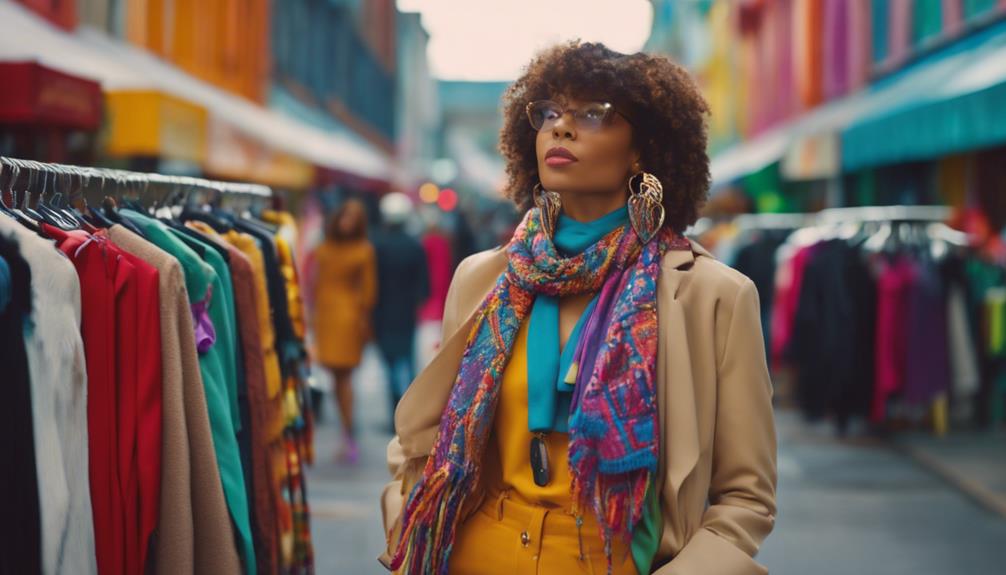
When it comes to styling tips, you'll want to focus on versatile layering pieces that can easily shift through the seasons.
By creating a seasonal capsule wardrobe, you can mix and match items to maximize your outfits without overspending.
Layering not only adds dimension to your look but also keeps your style fresh and adaptable.
Versatile Layering Pieces
Versatile layering pieces are essential for creating stylish outfits that easily shift from casual to formal occasions. Investing in high-quality items like lightweight cardigans and tailored blazers allows you to maximize your outfit potential. Opt for neutral colors such as black, beige, and navy; these shades guarantee your layering items can be paired seamlessly with various outfits.
Start with basics like long-sleeve turtlenecks and basic tees as your foundation. These essentials not only provide warmth but also add dimension to your looks. To elevate a simple outfit, experiment with textures—pairing a chunky knit sweater with a sleek silk blouse can create visual interest without overwhelming your ensemble.
Don't forget the power of accessories! Scarves and statement belts can transform basic outfits into chic ensembles, allowing for personal expression without a hefty price tag.
Seasonal Capsule Wardrobe Combinations
Creating a seasonal capsule wardrobe lets you effortlessly mix and match around 30-40 essential pieces for endless outfit possibilities.
To maximize your capsule wardrobe, start by selecting a cohesive color palette. Stick to neutrals while adding a few accent colors that complement each other, ensuring every piece coordinates seamlessly.
Incorporate timeless staples, like a little black dress and tailored trousers. These versatile items can shift from casual outings to formal events with just a change of accessories.
When you plan your outfits, think about layering techniques. Pair lightweight tops with cardigans or blazers to adapt to varying temperatures and occasions.
Don't forget to regularly reassess your capsule wardrobe each season. This helps you maintain relevance and style while ensuring you wear and appreciate all your pieces.
Rotate items in and out based on trends and personal preferences, allowing your wardrobe to evolve without excessive spending.
Layering for Versatile Outfits
Layering outfits skillfully allows you to adapt your style effortlessly for any occasion or climate. By combining different pieces, you can create versatile outfits without needing a large wardrobe. Start with lightweight, breathable fabrics like cotton or linen as your base layers. These materials keep you comfortable while adding depth to your look.
To elevate your outfit, incorporate accessories such as scarves, cardigans, and vests. These pieces not only provide warmth but also transform a simple outfit into something stylish. Don't hesitate to experiment with varying lengths and textures—pairing a longer tunic with a cropped jacket can add visual interest and create a polished silhouette.
Using a monochromatic color scheme in your layering can enhance sophistication and elongate your figure, making your overall look appear more cohesive. By thoughtfully selecting your layers and accessories, you can easily shift from day to night or adapt to changing temperatures.
Shopping Guide
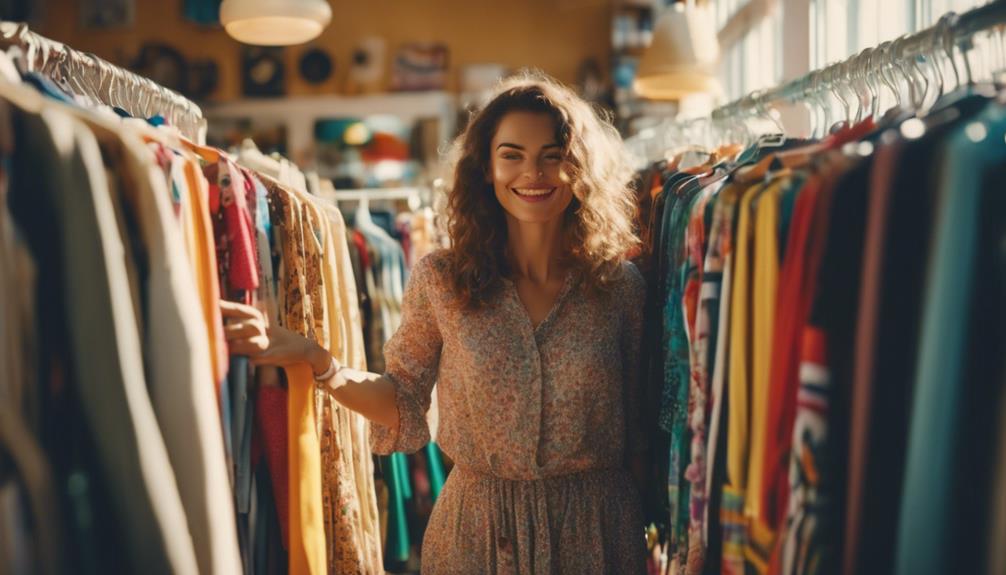
To save money while staying stylish, explore secondhand shopping platforms like ThredUp and Poshmark, where you can find trendy pieces at an average of 45% off retail prices. Embracing secondhand shopping not only boosts your wardrobe but also contributes to sustainable fashion.
Consider implementing the 30-day purchase rule. This helps you reflect on your clothing desires, reducing impulse buys and increasing satisfaction with what you add to your closet. Engage in price comparisons and evaluate cost-per-use for smarter purchasing decisions. Prioritize frequently worn items that provide better value over time.
Don't forget to subscribe to newsletters from your favorite brands. This way, you'll receive alerts about promotions, exclusive deals, and sales, maximizing your savings on quality items.
Another fun and cost-effective option is to attend clothing exchange parties or swap clothes with friends. This invigorating approach allows you to rejuvenate your wardrobe without spending a dime.
Upcycled Fashion Projects

You can transform your old garments into something new and stylish with a little creativity.
By adding patches or embroidery, you'll not only personalize your wardrobe but also showcase your unique style.
Upcycling not only reduces waste but also makes your fashion choices truly one-of-a-kind.
Repurposing Old Garments Creatively
Transforming old garments into stylish new pieces is a fun and eco-friendly way to express your unique fashion sense. One of the easiest and most rewarding projects involves repurposing jeans into tote bags or denim skirts. You'll not only save money but also reduce textile waste, making a positive impact on the environment.
Start by selecting a pair of jeans that you no longer wear. For a tote bag, cut off the legs and sew the bottom closed, adding straps from the remaining fabric. If you prefer a denim skirt, simply cut the jeans to your desired length and hem the edges. You can get creative with embellishments like fabric paint or decorative stitching to personalize your creation.
Hosting upcycling workshops with friends can make this process even more enjoyable. Share ideas, techniques, and materials, fostering a sense of community and inspiring each other to embrace sustainable fashion choices.
Additionally, simple repairs, such as sewing on new buttons or fixing hems, can extend the life of your clothing. By embracing these methods, you'll cultivate a frugal mindset and showcase your individuality through your wardrobe.
Personalize With Patches and Embroidery
Adding patches and embroidery to your garments not only personalizes your style but also gives new life to your wardrobe while promoting sustainable fashion practices. This approach is perfect for those embracing frugal fashion. By customizing thrifted items, you can transform them into standout pieces that reflect your individuality without breaking the bank.
Using basic sewing skills, you can complete many DIY embroidery projects easily and affordably. Patches can also serve a practical purpose, allowing you to repair worn areas of your clothing. This not only extends the lifespan of your garments but also reinforces your commitment to reducing textile waste.
Engaging in these upcycled fashion projects fosters creativity while supporting the slow fashion movement. You're not just making a fashion statement; you're contributing to mindful consumption by breathing new life into items that might otherwise end up in a landfill.
Cultural Impact
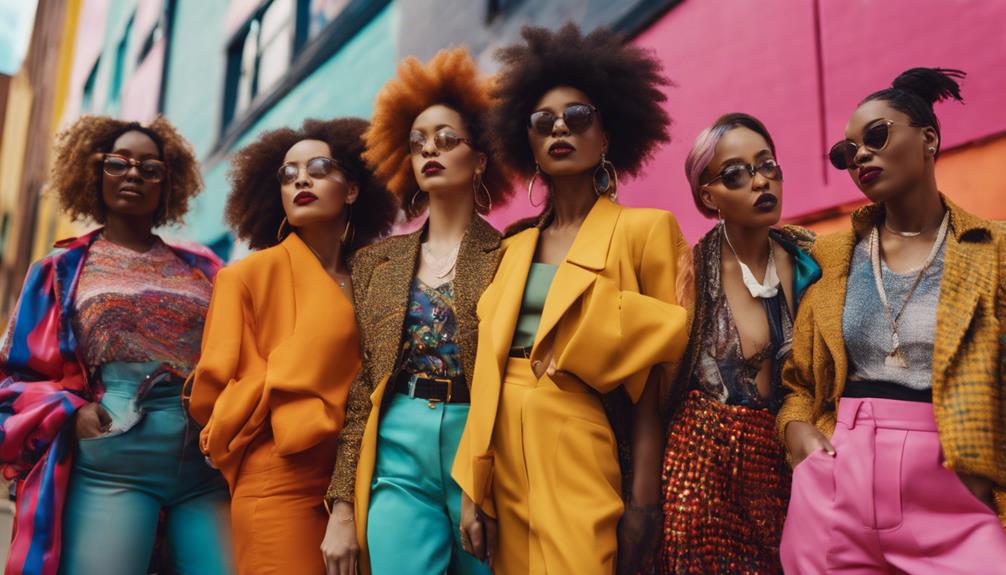
You can see how celebrity advocates for slow fashion are reshaping perceptions around style and sustainability.
By actively promoting ethical fashion, they inspire you to contemplate not just what you wear, but how it impacts the world.
This movement not only encourages personal expression but also fosters a sense of community around responsible choices.
Celebrity Slow Fashion Advocates
As celebrities like Emma Watson and Livia Firth champion slow fashion, they not only promote sustainability but also inspire a cultural shift towards ethical consumerism in the fashion industry. You might feel confident in knowing that when you support these advocates, you're contributing to a movement that values transparency over fast fashion. Years ago, many of us were unaware of the impacts of our purchases, but now, you can enjoy wearing pieces from your favorite brands that prioritize ethical sourcing.
The Fashion Revolution movement encourages you to ask, 'Who made my clothes?'—a question that helps you feel good about your spending. When you're on a tight budget, look for affordable options that align with these values. You'll absolutely love finding stylish alternatives through affiliate links that offer discounts, making it easier to shop sustainably.
If you've enjoyed this video on sustainable fashion, make sure to share your thoughts via email address. It's one of my favorite ways to connect with others on this journey. Together, we can find another way to celebrate style without compromising our beliefs, especially for special occasions. So, let's love dearly and choose fashion on a budget that truly reflects our values!
Ethical Fashion Activism
The rise of ethical fashion activism reflects a broader cultural awakening to the social and environmental consequences of the fashion industry, encouraging consumers to make informed choices about what they wear.
You're likely aware that this movement promotes awareness of sustainable practices and fair labor conditions for garment workers worldwide. By prioritizing transparency in supply chains, ethical fashion advocates push for greater accountability in how clothing is produced.
With a 2021 report from McKinsey revealing that 66% of consumers are willing to pay more for sustainable brands, it's clear that you're not alone in wanting to support ethical choices. These initiatives often highlight the work of local artisans and craftspeople, helping to preserve cultural heritage while boosting community economies through traditional garment-making techniques.
Social media platforms amplify this movement, inviting you to participate in campaigns and challenges that encourage sustainable fashion choices. As you rethink your purchasing habits and share your experiences, you're contributing to a more conscious fashion culture.
This shift not only impacts your wardrobe but also fosters a collective responsibility towards a more ethical and sustainable fashion industry.
Frequently Asked Questions
How to Be Fashionable on a Low Budget?
To be fashionable on a low budget, embrace secondhand shopping, implement a 30-day rule for purchases, invest in versatile pieces, and participate in clothing exchanges. You'll create stylish looks without breaking the bank!
How to Look Expensive on a Budget Female?
To look expensive on a budget, focus on darker colors and tailored fits. Invest in classic staples, mix high and low fashion, and maintain a polished appearance through grooming and signature makeup for added confidence.
How to Look Boujee on a Budget?
To look boujee on a budget, choose darker colors and classic pieces. Invest in tailored items, prioritize quality fabrics, and accessorize wisely. Thrift unique finds to elevate your style without overspending. You'll impress effortlessly.
How Do You Dress Nice With Little Money?
To dress nice with little money, prioritize secondhand shopping, invest in versatile pieces, and embrace upcycling. Focus on quality basics that mix and match, and implement a 30-day rule to avoid impulse purchases.
How Can I Achieve a Stylish Look on a Budget Using 1950s Fashion Inspiration?
Achieving a stylish look on a budget is possible with elegant 1950s fashion looks as inspiration. Look for high-waisted trousers and A-line skirts at thrift stores. Mix and match timeless pieces with modern accessories for a retro-chic look without breaking the bank. Embrace the classic, elegant 1950s fashion looks!
Conclusion
In wrapping up, embracing frugal female fashion lets you express your style without breaking the bank.
By understanding its origins and key characteristics, you can create chic looks that reflect your personality.
With handy styling tips and a savvy shopping guide, you'll find the perfect pieces for your wardrobe.
Plus, upcycling not only saves money but also contributes to sustainability.
So go ahead, get creative, and enjoy the journey of fashionable savings!
